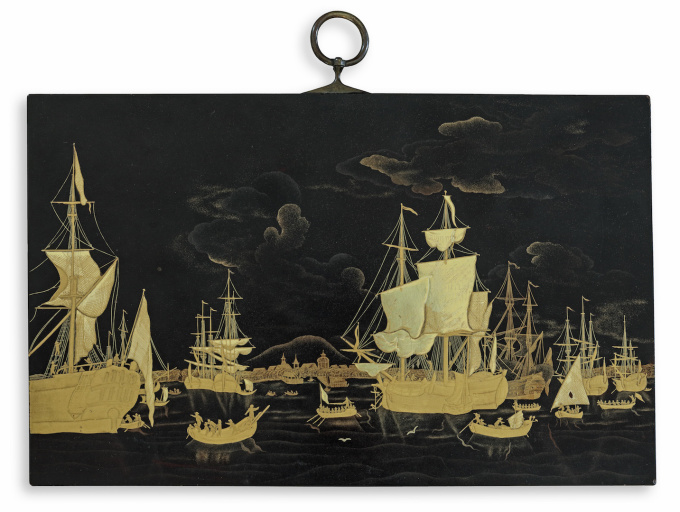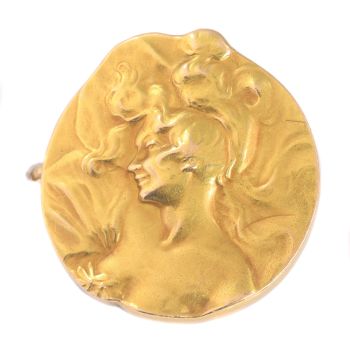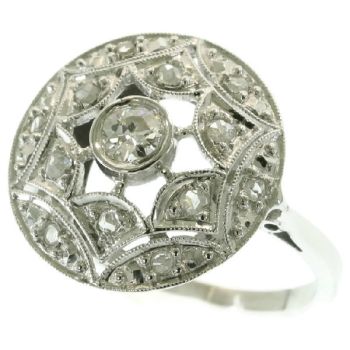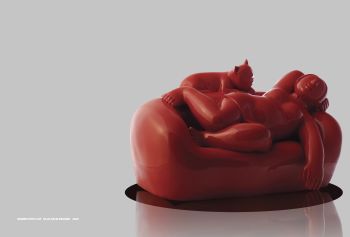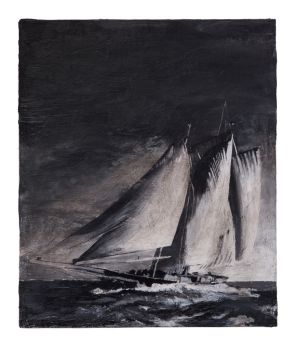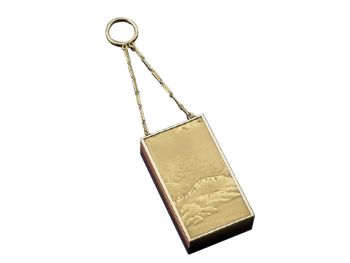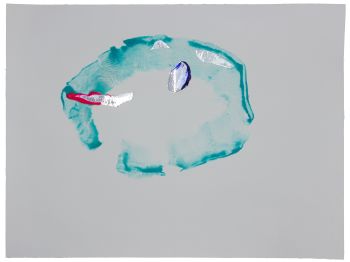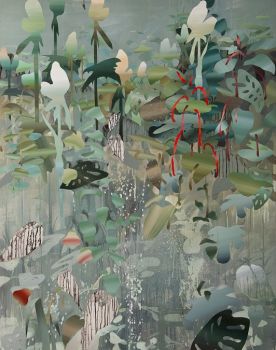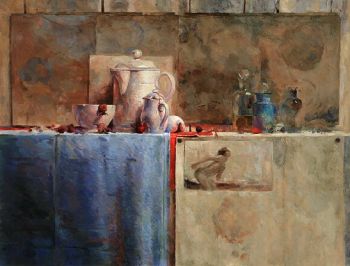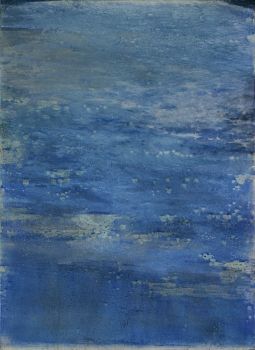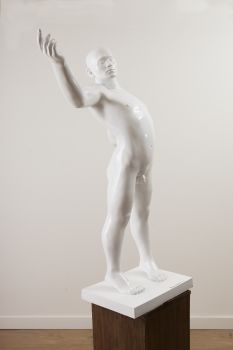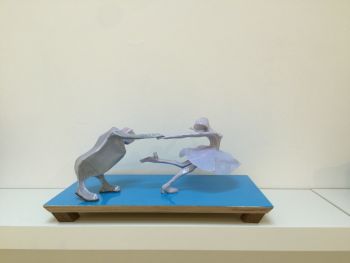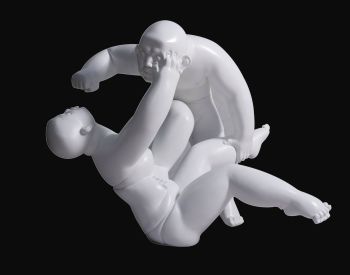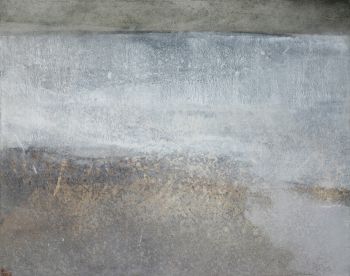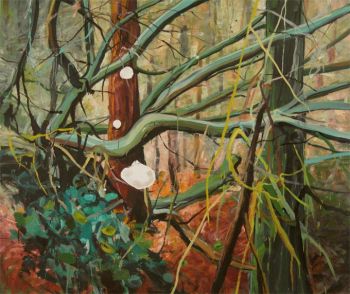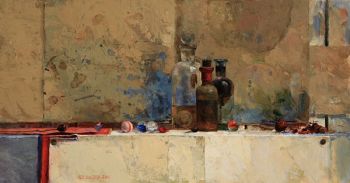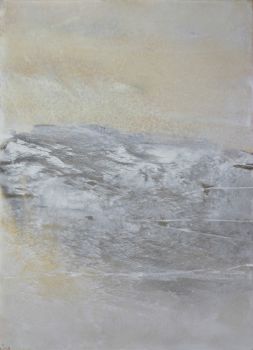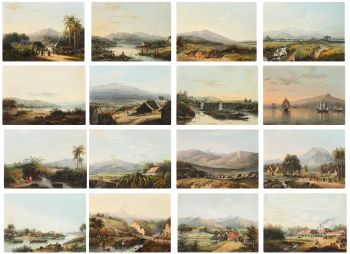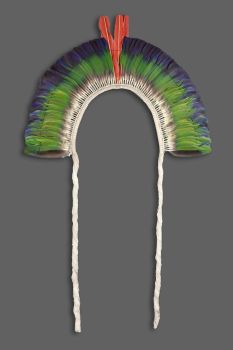EINE JAPANISCHE LACKKLAPPE, DIE DIE STRASSE VON BATAVIA DURCH 'LAKWERKER SASAYA' BESCHREIBT. 1780 - 1820
Unbekannter Künstler
Lack
Derzeit nicht über Gallerease verfügbar
Zebregs & Röell - Fine Art - Antiques
- Über Kunstwerk
By “LAKWERKER SASAYA” (act. circa 1780-1820), Nagasaki, Edo period circa 1800
At the reverse an inscription reading: De Reede van Batavia with the coat of arms of the town Batavia, a sword with a laurel wreath, amidst banners, cannons, nautical instruments and a Dutch lion holding a spear topped by a “liberty-cap”.
With a label at the reverse reading: “Tegen het eind van de 18e eeuw trad ene Van Reede op als gouverneur van de VOC te Decima. Hij liet een aantal plaquettes vervaardigen naar voorbeeld van uit Holland meegebrachte gravures” (towards the end of the 18th century Van Reede was head of the VOC at Decima. He ordered several plaques after Dutch prints he had taken to Nagasaki).
Black lacquer on copper, decorated and inscribed in gold and silver, hiramaki-e, togidashi and sparse mura-nashiji.
H. 17.5 x W. 28 cm
Note:
This scene with Dutch ships at anchor on the roadstead of Batavia was copied after an engraving by Mattias de Sallieth, after a drawing by Hendrik Kobell (1751-1799) and published in Batavia, de hoofdstad van Nederlands Oost-Indië, 1782-1783. In Uit Verre Streken June 2011, item 2, a Japanese lacquered writing box is illustrated with the same scene and also inscribed “DE REEDE VAN BATAVIA” (roadstead of Batavia), in an oval with the arms of Batavia underneath, after the same engraving based on a drawing by Hendrik Kobell, as was used for the present plaque. The interior of the box is fitted with compartments for writing implements and a glass inkwell, beneath a hinged cover inscribed “ LAKWERKER SASAYA”. So SASAYA certainly possessed the engraving of the roadstead of Batavia which was used for the present lacquer plaque, as well as for the writing box, suggesting that the present plaque is also by his hand. Sofar only four other pieces with Sasaya’s mark were known, a lacquer plaque depicting the sea battle on Doggersbank (Rijksmuseum Amsterdam, inv. NM 6309), a scene in ancient Rome (Rijksmuseum Amsterdam, inv. RBK 1960-29), both dated 1792, and a pair of secrétaires, one depicting the landing of British troops in Holland in 1799 (Rijksmuseum Amsterdam, inv, NG 401) and the other representing the sea- battle of Kamperduin of 1797 (Maritime Museum Prins Hendrik Rotterdam, inv. M 1913), both inscribed “LAKWERKER SASAYA” in an oval inside the lid.
Recently we found two very similar secrétaires both signed on the same place inside the lid LAKWERKER SASAYA, one inscribed on the front with the name “Olivia”. According to Oliver Impey & Christiaan Jörg, Japanese export lacquer 1580-1850, Amsterdam, 2005, p.53-57 and 266-267, the figure of Sasaya remains elusive. It is not clear from the existing records whether Sasaya was an individual lacquer worker, a representative of a workshop, a wholesaler or a merchant. Besides, the name Sasaya was not uncommon and appeared in the Dutch “Dagregisters” (journal) of Decima as early as 1776. - Über Künstler
Es kann vorkommen, dass ein Künstler oder Hersteller unbekannt ist.
Bei einigen Werken ist nicht zu bestimmen, von wem sie hergestellt wurden, oder sie wurden von (einer Gruppe von) Handwerkern hergestellt. Beispiele sind Statuen aus der Antike, Möbel, Spiegel oder Signaturen, die nicht klar oder lesbar sind, aber auch einige Werke sind überhaupt nicht signiert.
Außerdem finden Sie folgende Beschreibung:
•"Zugeschrieben …." Ihrer Meinung nach wohl zumindest teilweise ein Werk des Künstlers
•„Atelier von ….“ oder „Werkstatt von“ Ihrer Meinung nach eine Arbeit, die im Atelier oder in der Werkstatt des Künstlers, möglicherweise unter seiner Aufsicht, ausgeführt wurde
•„Kreis von ….“ Ihrer Meinung nach ein Werk aus der Zeit des Künstlers, das seinen Einfluss zeigt, eng mit dem Künstler verbunden, aber nicht unbedingt sein Schüler
•"Art von …." oder „Anhänger von ….“ Ihrer Meinung nach eine Arbeit, die im Stil des Künstlers ausgeführt wurde, aber nicht unbedingt von einem Schüler; kann zeitgenössisch oder fast zeitgenössisch sein
•„Art von ….“ Ihrer Meinung nach ein Werk im Stil des Künstlers, aber späteren Datums
•"Nach …." Ihrer Meinung nach eine Kopie (jegliches Datums) eines Werks des Künstlers
• „Unterzeichnet …“, „Datiert …“. oder „Beschriftet“ Ihrer Meinung nach wurde das Werk vom Künstler signiert/datiert/beschriftet. Das Hinzufügen eines Fragezeichens weist auf einen Zweifel hin
• „Mit Unterschrift …“, „Mit Datum …“, „Mit Aufschrift ….“ oder „Trägt Unterschrift/Datum/Beschriftung“ ihrer Meinung nach die Unterschrift/Datum/Beschriftung von jemand anderem als dem Künstler hinzugefügt wurde
Sind Sie daran interessiert, dieses Kunstwerk zu kaufen?
Artwork details
Related artworks
- 1 - 4 / 12
Unbekannter Künstler
A rare Japanese export lacquer medical instrument box1650 - 1700
Preis auf AnfrageZebregs & Röell - Fine Art - Antiques
Unbekannter Künstler
The Stamford Raffles Secretaires.1800 - 1813
Preis auf AnfrageZebregs & Röell - Fine Art - Antiques
1 - 4 / 20Unbekannter Künstler
The Stamford Raffles Secretaires.1800 - 1813
Preis auf AnfrageZebregs & Röell - Fine Art - Antiques
Unbekannter Künstler
EINE SAMMLUNG VON VIER SRI LANKAN IVORY BIBELKÄSTCHEN18th century
Preis auf AnfrageZebregs & Röell - Fine Art - Antiques
1 - 4 / 24Unbekannter Künstler
EINE SAMMLUNG VON VIER SRI LANKAN IVORY BIBELKÄSTCHEN18th century
Preis auf AnfrageZebregs & Röell - Fine Art - Antiques
Unbekannter Künstler
Japanese transition-style lacquer coffer 1640 - 1650
Preis auf AnfrageZebregs & Röell - Fine Art - Antiques
Unbekannter Künstler
The bell of the VOC fortress in Jaffna, Sri Lanka1747
Preis auf AnfrageZebregs & Röell - Fine Art - Antiques
 Kuratiert von
Kuratiert vonDanny Bree
Unbekannter Künstler
EIN JAPANISCHES MODELL EINES NORIMONO, EINES PALANQUINS1650 - 1700
Preis auf AnfrageZebregs & Röell - Fine Art - Antiques
Unbekannter Künstler
Zwei Studienporträts von Mas Marco Kartodikromo1900 - 1950
Preis auf AnfrageZebregs & Röell - Fine Art - Antiques
Unbekannter Künstler
EIN UNGEWÖHNLICHES INDONESISCHES SILBERGERICHTlate 17th
Preis auf AnfrageZebregs & Röell - Fine Art - Antiques
Unbekannter Künstler
Holländer in Miniatur (Netsuke)1700 - 1900
Preis auf AnfrageZebregs & Röell - Fine Art - Antiques
Unbekannter Künstler
A silver spoon commemorating Juff’ Margareta van Hoorn1656 - 1694
Preis auf AnfrageZebregs & Röell - Fine Art - Antiques
1 - 4 / 24Unbekannter Künstler
A rare Japanese export lacquer medical instrument box1650 - 1700
Preis auf AnfrageZebregs & Röell - Fine Art - Antiques
Unbekannter Künstler
The Stamford Raffles Secretaires.1800 - 1813
Preis auf AnfrageZebregs & Röell - Fine Art - Antiques
1 - 4 / 24Dutch School
Ankunft eines niederländischen Ostindianers in der Table Bay18th century
Preis auf AnfrageZebregs & Röell - Fine Art - Antiques
Abraham Salm
Twenty-four chromolithographs of Java after A. Salm”1801 - 1876
Preis auf AnfrageZebregs & Röell - Fine Art - Antiques
Unbekannter Künstler
Eine JURUNA TRIBE FEATHER HEADDRESS1900 - 1950
Preis auf AnfrageZebregs & Röell - Fine Art - Antiques
1 - 4 / 12

